Final Exam
1/36
Earn XP
Description and Tags
Mostly population genetics and Hardy-Weinburg equations
Name | Mastery | Learn | Test | Matching | Spaced |
|---|
No study sessions yet.
37 Terms
Motoo Kimura
1968
proposed Neutral Theory
Neutral Theory
there is a natural mutation rate leading to changes in alleles
some alleles will get selected again while others may drift in frequency due to random genetic drift. It emphasizes that many genetic variations are not driven by natural selection but occur by chance.
How are Hardy-Weinberg equations predicted?
predicts how alleles flow/are maintained in a population
what does p equal?
the frequency of the 1st allele in a population
what does q equal?
the frequency of the 2nd allele in a population
what is the first rule of Hardy-Weinburg equations?
p + q = 1.0
Represents allele frequencies
what is the second rule of Hardy-Weinburg equations?
The genotype frequencies can be calculated using p² + 2pq + q² = 1.
conditions that need to be met in a Hardy-Weiberg equation
the population must be infinitely large
must be random mating
population isn’t subject to evolutionary forces
if p = 0.7 and q = 0.3 in a population, what is the probability that you will have a homozygous disease (aa)?
To find the probability of being homozygous recessive (aa), use the formula q². Therefore, if q = 0.3, then q² = 0.3² = 0.09, which means there is a 9% chance that the population is homozygous for this disease
if p = 0.7 and q = 0.3 in a population, what is the probability that you will have a homozygous disease (AA)?
To find the probability of being homozygous dominant (AA), use the formula p². Therefore, if p = 0.7, then p² = 0.7² = 0.49, which means there is a 49% chance that the population is homozygous for this trait.
if p = 0.7 and q = 0.3 in a population, what is the probability that you will have a heterozygous disease (Aa)?
To find the probability of being heterozygous (Aa), use the formula 2pq. Therefore, if p = 0.7 and q = 0.3, then 2pq = 2(0.7)(0.3) = 0.42, which means there is a 42% chance that the population is heterozygous for this trait.
PKU is a rare metabolic disorder and is homozygous recessive. It occurs in 1/14,000 live births.
What percentage of the population is a carrier (assuming homozygous recessive disease)?
(7.14 × 10-5) 1/14,000 = q2 (frequency that is homozygous recessive)
q = √1/14,000 = 0.00845
p = 1 - q = 1 - 0.00845 = 0.992
Heterozygous = 2pq = 2(0.992)(0.00845) = 0.0168
Therefore, there is approximately a 1.68% chance that an individual in the population is a carrier for PKU.
what is another method for figuring out equilibrium regarding p?
p = p2 +1/2 (2pq)
p2 = whatever AA is
1/2(2pq) = ½ of Aa
what is another method for figuring out equilibrium regarding q?
q = q2+ 1/2(2pq)
q2 = frequency of aa
AA = 0.2
Aa = 0.6
aa = 0.2
what is genotype frequency of the population in relation to p?
p = 0.2 + ½ (0.6) = 0.5
half the population is AA (p)
AA = 0.2
Aa = 0.6
aa = 0.2
what is genotype frequency of the population in relation to q?
q = 0.2 + ½ (0.6) = 0.5
half the population is aa (q)
Blood typing
MM = 1101
MN = 1406
NN = 503
What is the allele frequency, and is the population in equilibrium?
1101 + 1406 + 503 = 3100
1101/3100 = 0.355 (p2)
1406/3100 = 0.483 (2pq)
503/3100 = 0.162 (q2)
Allele frequency:
p = 0.355 + ½ (0.483) = 0.597 (M)
q = 0.162 + ½ (0.483) = 0.403 (N)
0.597 + 0.403 = 1
MM = (0.597)2 = 0.357
MN = 2(0.597)(0.403) = 0.481
NN = (0.403)2 = 0.162
0.357 × 3100 = 1107
0.481 × 3100 = 1491
0.162 × 3100 = 502
Chi square:
(O-e) = -6, 5, 1
(O-e)2 = 36, 25, 1
(O-e)2 /e = 0.0325, 0.168, 0.002
X2 = 0.0513
d.F = 2
0.95 < p < 0.99
Data fits what we expected, the population is in equilibrium
Fish
AA = 80
Aa = 280
aa = 640
Allele frequency? Is the population in equilibrium?
80 + 280 + 640 = 1000
80/1000 = 0.08 (p2)
280/1000 = 0.28 (2pq)
640/1000 = 0.64 (q2)
Allele frequency:
p = 0.08 + ½ (0.28) = 0.22
q = 0.64 + ½ (0.28) = 0.78
0.22 + 0.78 = 1
p2 = (0.22)2 = 0.0484
2pq = 2(0.22)(0.78) = 0.3432
q2 = (0.78)2 = 0.6084
0.0484 × 1000 = 48.4
0.3432 × 1000 = 343.2
0.6084 × 1000 = 608.4
Chi square:
(O-e) = 31.6, -63.2, 31.6
(O-e)2 = 998.56, 3994.24, 998.56
(O-e)2 /e = 20.63, 11.64, 1.64
X2 = 33.91
d.F = 2
p < 0.01
The population is not in equilibrium
what are some reasons what can cause changes in allele frequencies?
mutations
relatively rare
random
look at development of new allele
migrations
how much goes on
genetic drift
Founder effect
Genetic bottleneck
Founder effect
big population at first → small group breaks away
Achondroplasia (dwarfism)
1.4 × 10-5 mutations/allele
population of 500,000 individuals = 1,000,000 gametes
how long will it take for p and q to roughly equal 0.5
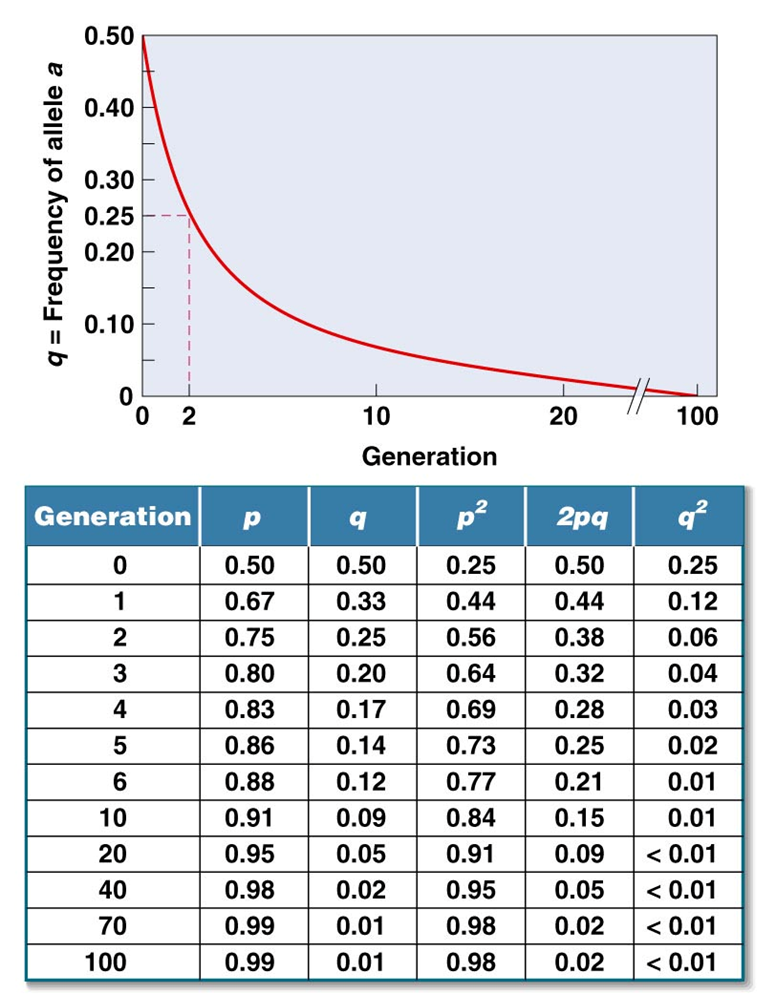
p = 1.0
q = 0.0
1,000,000 × 1.4 × 10-5 = 14 alleles in the next generation
p = 0.999986
q = 0.000014
Next gen = 14 dominant alleles and 999,986 recessive alleles
It will take roughly 70,000 generations for q and p to roughly equal 0.5
really slow mutation rates
In a population with 100 individuals
Frequency of A (p) = 0.5
Frequency of a (q) = 0.5
100% AA - survive and reproduce
90% Aa - survive and reproduce
80% aa - survive and reproduce
Assume population is in equilibrium
WAA = 1.0
WAa = 0.9
Waa = 0.9
AA = (0.5)2 = 0.25 = 25
Aa = 2(0.5)(0.5) = 0.5 = 50
aa = (0.5)2 = 0.25 = 25
A = 2(25)(1) + 1(50)(0.9) = 95
a = 1(50)(0.9) + 2(25)(0.8) = 85
95 + 85 = 180
95/180 = 0.53 = p
85/180 = 0.47 = q
These are an Individual’s fitness
directional selection
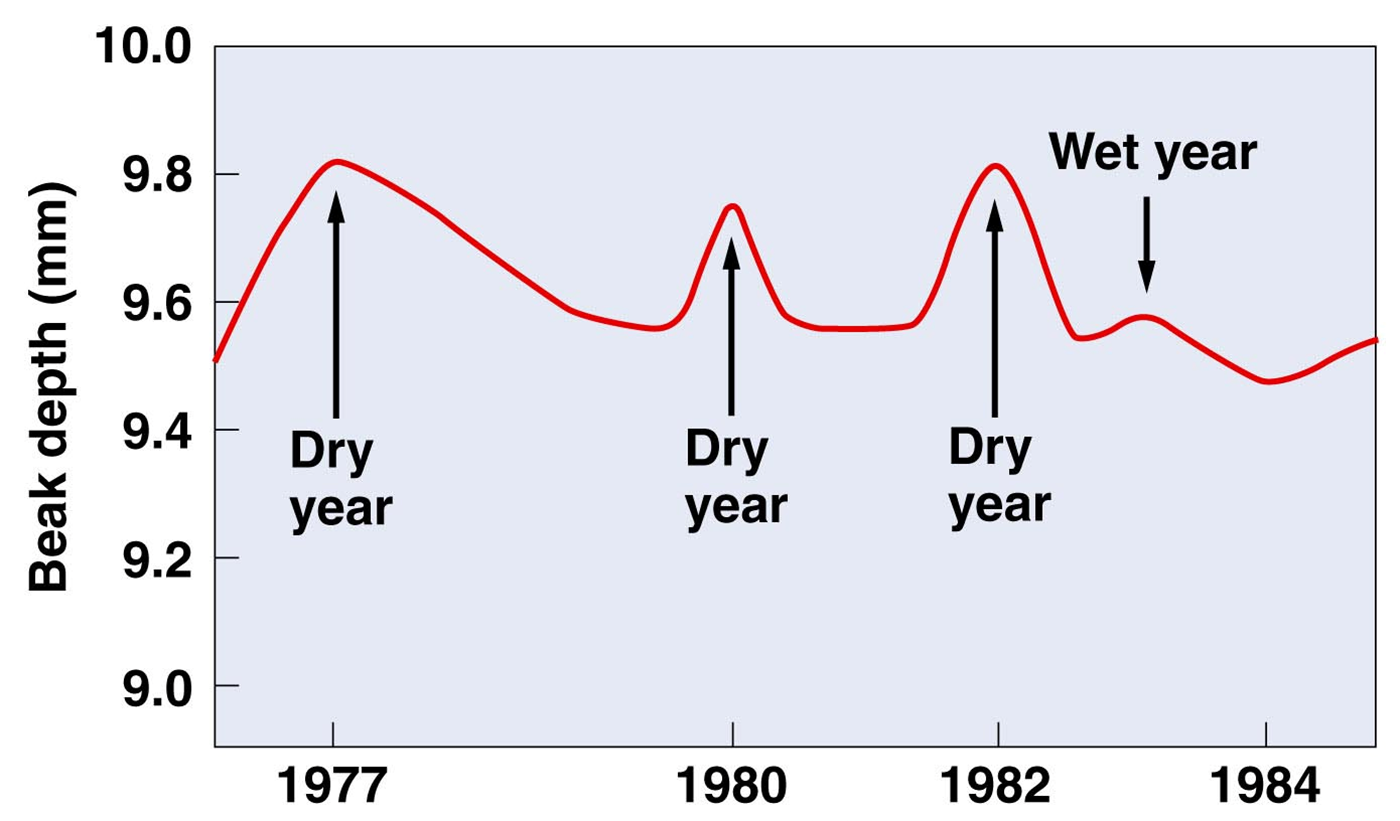
some sort of force pushing a bell curve in one direction
ex: beaks in finches
stabilizing selection
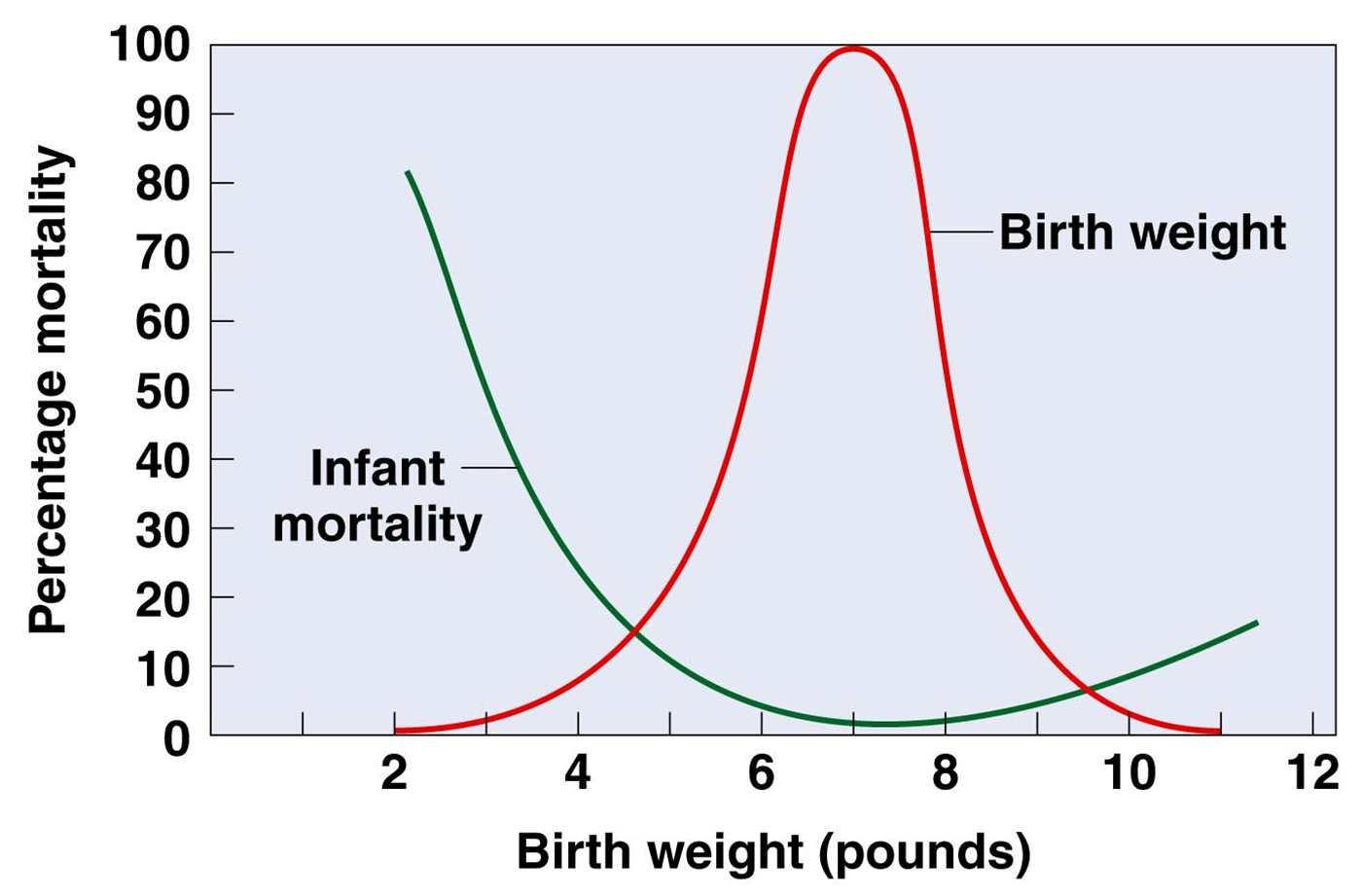
selects against the extremes
ex: human birth weight
disadvantage for heaviest and lightest babies
disruptive selection
selection favors the extremes
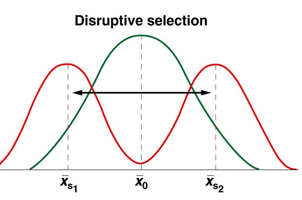
what drives speciation?
disruptive selection
what drives evolution?
directional selection
what prevents speciation?
migration
prezygotic isolating mechanism
things that prevent 2 individuals in a population to mate
postzygotic isolating mechanism
if members are willing/able to mate but aren’t able to produce viable offspring
ex: mule, liger
The Pacific Ocean and the Caribbean Sea are connected at Panama. There were 7 different populations of shrimp in the Pacific and Caribbean respectfully. When the Panama Canal opened, both populations evolved and were a different species. Could they still mate?
3/7 - could not mate
4/7 - could mate
60% of the eggs are viable
what lake had 1 species of fish evolve into over 500 species?
Lake Victoria
The more divergence there is in DNA sequences…
the less related a species is to another
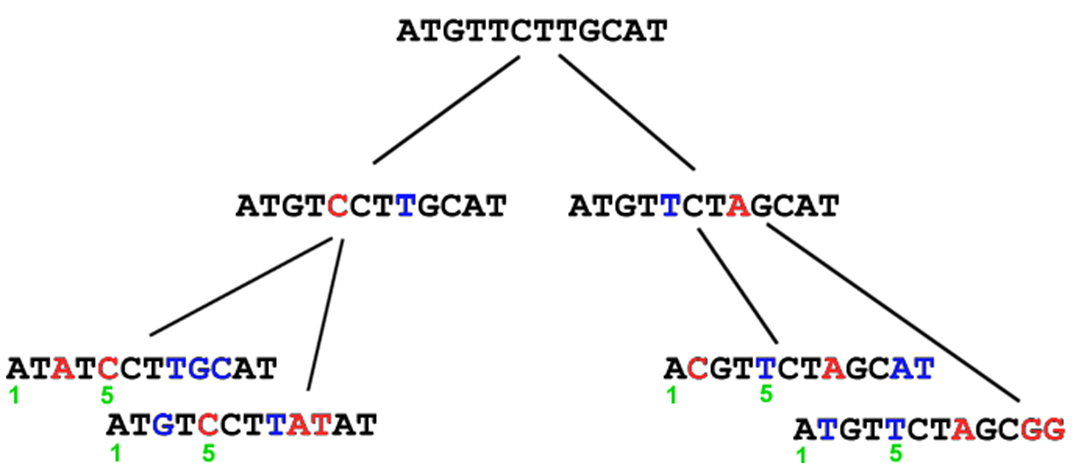
BRCA1 and BRCA2
associated with breast cancer
DNA damage repair
very big genes
10,000 nucleotides
conserved
critical for BRCA1 and BRCA2
what does polygenetic inheritance show
shows some sort of quantitative inheritance
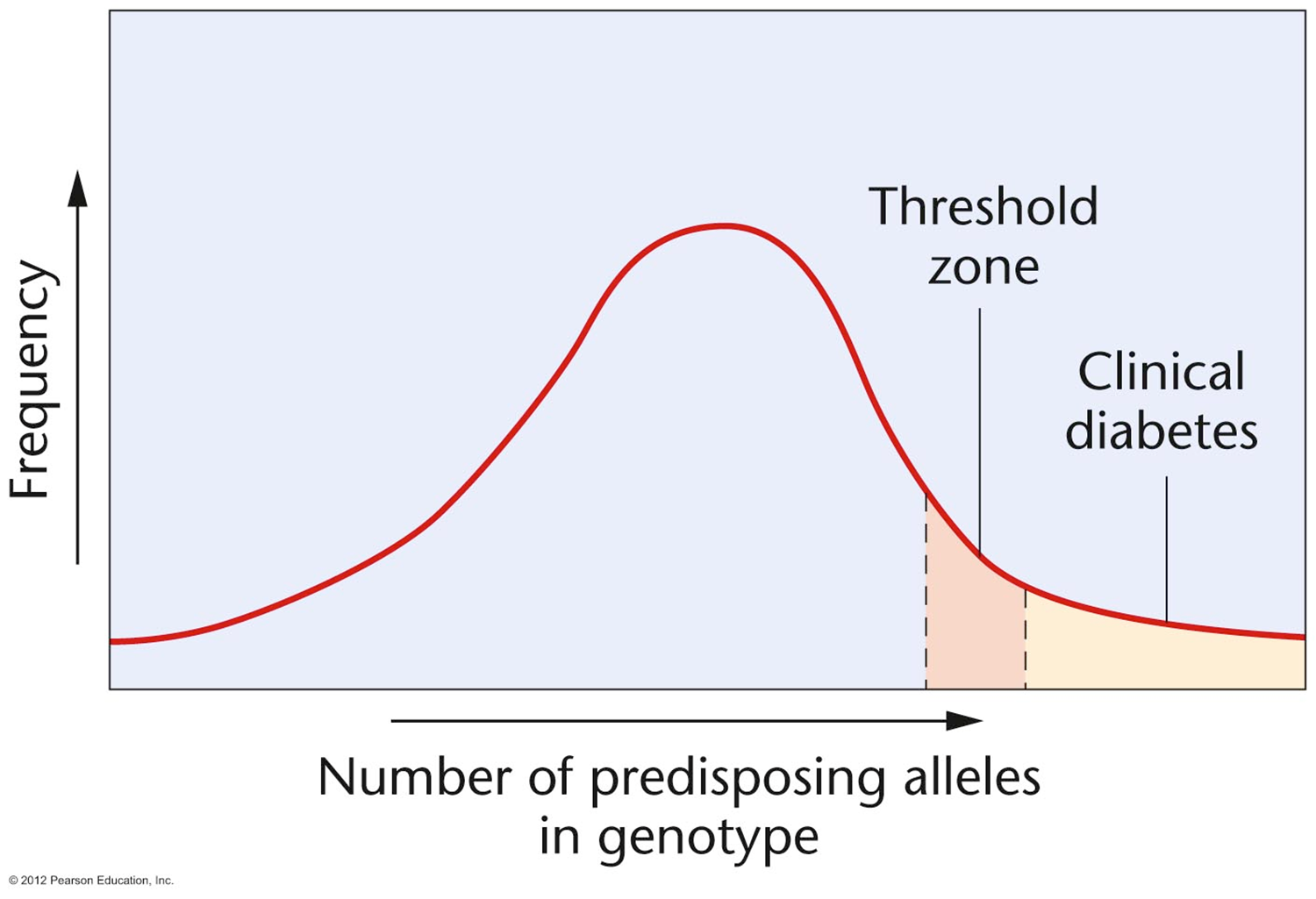
meristatic traits
phenotype is described in whole numbers
threshold traits
phenotype is when you either have it or you don’t
multiple genes determine if you have it or not